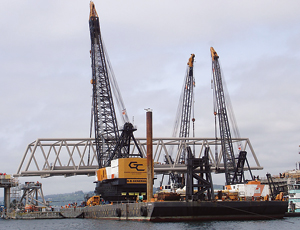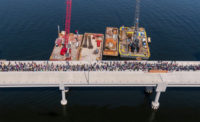The eastern half of the Hood Canal Bridge opened on June 3, eight days ahead of a schedule that was revised after a 15-month delay in 2005. Crews finished installing 17 pontoons for the 1.5-mile state Route 104 crossing. The world’s longest floating bridge over salt water links Washington state’s Olympic and Kitsap peninsulas about 60 miles north of Seattle.

Kiewit-General Construction Co., Poulsbo, Wash., earned a $600,000 bonus for the early opening. The $490-million project took six years, due in part to a 15-month delay after an ancient Native American village was uncovered at the site of a planned graving dock (ENR 6/12/06 p. 16). Reparations to the S’Klallam Tribe and the delay cost over $100 million.
Work called for removal and replacement of the east span, including anchors, pontoons, drawbridge and trusses. “This is not your typical bridge,” says Scott Ireland, Washington Dept. of Transportation project manager. “It includes electrical, mechanical and hydraulic systems.”
The goal is to prevent a repeat of the 1979 sinking of the western half, now replaced, after 120-mph winds blew across the canal. Hydraulic anchors and two trusses that can bend 36 in. will help the new eastern half withstand these winds.
The 280-ft-long trusses, fabricated in Oregon under standards used by the oil industry, connect the pontoons to the concrete approaches. Electrical and mechanical systems are installed in the pontoons, which are post-tensioned rectangular concrete boxes. They were cast in a 150-ft-wide, 465-ft-long graving dock in Tacoma. Workers then opened a hole in the dock’s gate, allowing water to fill the dock and float the approximately 6,000-ton pontoons.
Tugboats towed the 17 pontoons, linked together into three sections as long as 943 ft, 35 miles to the site. Crews removed the existing pontoons. “Cutting apart the bridge went really well,” says Ireland. The new pontoons were ballasted with tolerances of only 1⁄8 in. every 10 ft. “We bought a laser surveying system used for marine projects just for that purpose,” says Phil Wallace, Kiewit-General proj-ect director. The pontoons were aligned and pulled together with temporary prestressing strands. After pumping out the water, crews post-tensioned and grouted the tendons.
The 1.6-million-lb trusses were lifted into place by a derrick barge with a 1.4- million-lb capacity and two additional derricks. “We had to plan this entire phase several years in advance just to make sure we would have that derrick available when we needed it,” says Wallace.
WashDOT spent $12 million to supply alternate transportation for the 20,000 daily vehicles that use the bridge, which is also used by the U.S. Navy for training. “We had to coordinate with them at least four times per day to make sure the channel was open at all times,” says Ireland.


Post a comment to this article
Report Abusive Comment